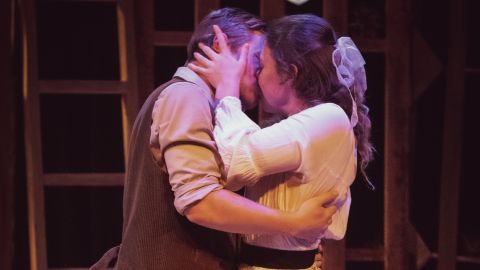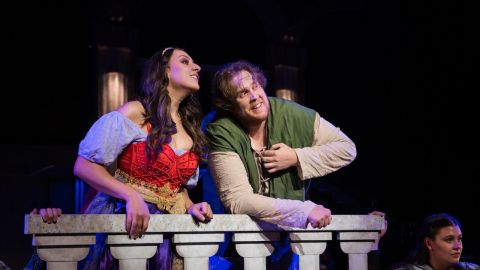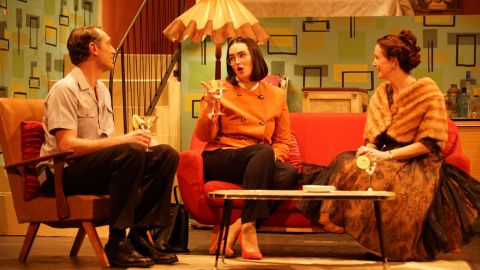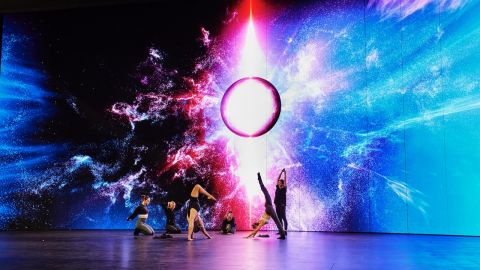Director’s Diary – The Beast
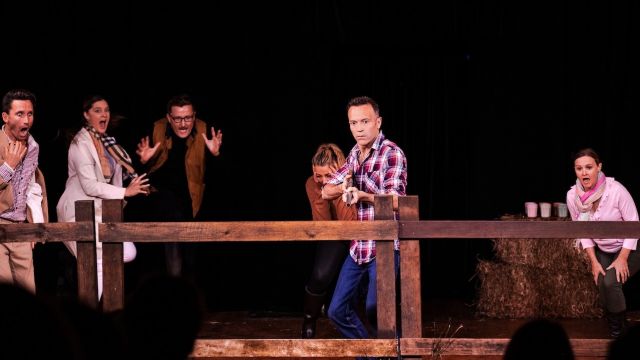
The Bangalow Theatre Company in northern NSW recently won five Gold Coast Palm Awards, including best community theatre production, for their season of The Beast by Eddie Perfect. Director Anouska Gammon explains how cast and venue challenges were conquered to produce the play in six weeks.
Our little company usually produces musicals, but I had my sights on this brilliant piece which I knew would resonate with local crowds. The black comedy plonks itself in the middle of upper-middle class Australia. Three married couples living in Melbourne, all seeking a more holistic life, move to a tree change existence that centres itself in organic orgasmic delight.

Writer Eddie Perfect has a knack for poking his audience in just the right way, feeding them humour to shade the truthful and exposing themes, while building to a crescendo of unravelling chaos.
The Bangalow Theatre Company is run by a group of volunteers passionate about creating innovative, thought-provoking and engaging theatre. With sell-out shows for each season, and multiple awards, the company has survived the pandemic, and is thriving.
We had only six weeks and twelve rehearsals to prepare for opening night due to cast reshuffling. Luckily the final cast took to the script like fish to water. We also had enough females audition to allow for a double cast. This meant we needed more rehearsal time but the double roles kept each male on their toes, as they needed to respond to each female differently.
The females themselves were also constantly finding their version of the character, and this little bit of competitiveness was just the right energy for the work. No one felt safe, or too comfortable, which added to the discomfort within the writing.

Another hurdle the company came up against was our venue. The initial space for The Beast was a shed on a local farm, which seemed like a great idea at the time. Placing the work in the environment which the play is set felt like a bold, and cost-effective choice.
However, as rehearsals began we realised that the shed would only allow for 50 patrons, we would need to bring in porta loos, there was a lack of a back stage area, no food/bar options and if it rained, we would need a marquee. The shed itself was up a very long driveway, with little parking.
We investigated having live cattle around the shed, and one live calf in the show, to submerge our audience in the play through natural sounds and realism, however this was not legally allowed.

So, we quickly needed to find another performance space four weeks out from the show.
Luckily, we had found another venue option - the Newrybar Hall - great in-between shed and theatre option for us, with a toilet as well! Rehearsals continued (in a different hall space) and tickets went on sale.
Things were coming together except for one last thing - the cow.

The finale of the first act is a monumental moment of the play, where the three couples decide to celebrate their new lives in the countryside with a fabulous degustation lunch. They plan to meet a local farmer to kill one of his cows, which the group will then prepare to eat. Head to tail eating it is called. So very sustainable. However, the farmer does not turn up, and so the couples take it on themselves to kill the cow.
This, of course, goes horribly wrong, and ends up being a full-blown cow massacre leaving the characters traumatised. We considered a puppet cow, the use of silhouettes, projection, another performer, a fake toy cow and the list went on.
Finally, a more simplistic idea formed that did not involve the sight of a cow, but rather the blood of a cow. We went into full engineering mode to create our cow blood device. This took many trips to hardware stores, pool shops, conversations with many tradies and battery experts.

We invested in a dog activated sprinkler, and tested other devices. Then, after many hours testing pressure and consistency for the blood, we made a device that was motorised and activated by the actors pressing a button.
The blood (a concoction of red food colouring, chocolate sauce and water) was kept in a large tub on stage masked as a hay bale. Blood travelled through a hose with a spray nozzle, and hidden under fake grass.
As the actors either tried to save or kill the cow, the button could be pushed, the blood would spray, and with the combination of horrific cow sounds and lighting, we had our scene. It was a triumph, and left each audience shocked, yet laughing.

There was also a massive job of cleaning up during each interval for our crew, and for our costume lady, who needed to continually wash blood ridden clothes for each show.
The Beast, as meaty (pardon the pun) as it was, will be a difficult act to follow for BTC. There were times when it did feel all too difficult. Six weeks from first script read to opening night with a group of volunteers, a very low budget, and no home to rehearse/perform in.
But perhaps there is something in this. Something in the restriction which aids creativity. Sometimes having too much time, and too much space creates more questions and allows for more opportunities to conflict. One thing is for sure, it is the work of a formidable team of passionate people, and the support of our local theatre loving community which does keep BTC moving forward.

Photographer: K Holmes.


